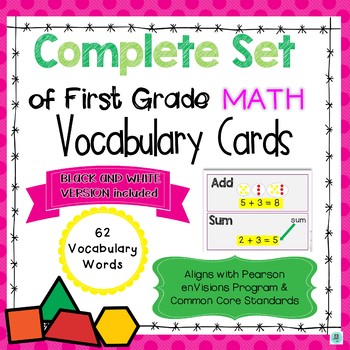Math Common Core and enVision Program Vocabulary Cards for Grade 1
- PDF
Also included in
- This resource is for a whole-school or math coordinator who needs vocabulary cards for a math word wall. This bundle includes a set of color and a set of black and white vocabulary cards for each grade K-5. These cards align with the Pearson enVision 2.0 programs. You can use these cards as a resourPrice $45.00Original Price $59.00Save $14.00
Description
LARGE and clear math vocabulary cards for your Math Word Wall!
➯ 62 COLOR Vocabulary Cards and 62 Black and White Cards
➯ Aligns with Pearson enVision Program for GRADE 1
➯ Color and black and white versions
STOP: Do you have the 2020 version of enVision?, buy those cards HERE.
Topics Included:
1: Solve Addition and Subtraction Word Problems to 10
2: Fluently Add and Subtract within 10
3: Addition Facts to 20- Use Strategies
4:Subtraction Facts to 20- Use Strategies
6:Represent and Interpret Data
7: Extend the Counting Sequence
8: Understand Place Value
9: Compare Two-Digit Numbers
12: Measure Lengths
13: Time
14: Reason with Shapes and Their Attributes
15: Equal Shares of Circles and Rectangles
PURCHASE these *once* and you will have a complete set of first grade math vocabulary cards! Great for bulletin boards and math centers!
Improves student learning of math concepts with GREAT visuals!






